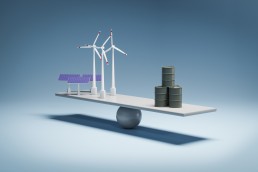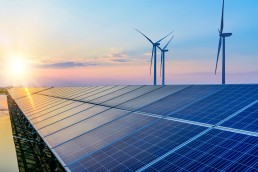The adoption of renewable energy is accelerating rapidly. According to the International Energy Agency (IEA), the worldwide capacity for renewable energy will increase by 60% by 2026. This growth will account for 95% of new energy capacity. This means the capacity of other power sources, like nuclear plants or fossil fuels, will only see limited expansion.
The IEA points out that the rapid adoption of renewables has increased demand for qualified professionals in areas like solar and wind power, heat pumps, and electric vehicles. The demand for professionals is especially pronounced in the U.S. The Bureau of Labor Statistics (BLS) projected a 68% growth in demand for wind turbine technicians and a 52% increase in demand for solar photovoltaic (PV) installers by 2030.
Demand goes beyond these hands-on professions to include engineers, architects, and data scientists familiar with the design, usage, and analysis of new energy systems.
Here is a look at eight career paths for those interested in the renewable energy sector.
Solar photovoltaic installer
Demand for qualified solar PV installers has increased as the price of solar falls and more homeowners and businesses consider adding panels to their energy systems. Not only do companies need installers to keep up with current demand, but they need more specialists to handle future growth.
Growth is on the horizon in the coming years. A 2022 survey by Forbes found that 48% of American homeowners who don’t yet have solar power plan to install PV panels in the future, making this an ideal time to consider a career as a PV panel installer.
A solar PV installer’s job duties include assessing each job site and planning systems based on the conditions and electricity needs of the customer. They then install panels and roof mounts, ensuring the system meets structural requirements and building codes.
This job requires electrical expertise to connect the panels to the home electrical system, inverters, or the electrical grid. Most PV installers are also qualified to perform maintenance on existing panels and systems.
The BLS puts the 2023 median salary for PV installers at $45,230 per year. Projections from September 2023 show the demand for qualified installers increasing by 22% between 2022 and 2032. In comparison, the average growth for all occupations will only be 3% during that timeframe.
Wind turbine technician
Wind turbine technicians install and maintain the mechanical machinery used to produce power. Wind turbines provided 10.2% of America’s electricity in 2022. Large turbines can provide energy at a utility-level scale, making it an attractive alternative to traditional power sources like coal and natural gas.
To maximize efficiency, turbines are tall, averaging 322 feet in height. Technicians climb the towers to install, repair, and perform routine maintenance on the mechanical components. They also collect data and install sensors for remote monitoring.
Technicians who complete post-secondary and on-the-job training earned a median salary of $57,320 in 2022, according to the BLS. The bureau predicts a 45% increase in demand for qualified professionals between 2022 and 2032 as companies and governments seek to use turbines on utility-scale projects.
Electrical engineer
Electrical engineers solve some of the most pressing problems related to renewable energy. They work on projects to increase the efficiency of renewable systems and help develop storage solutions necessary for systems with intermittent power generation.
Large solar arrays with ground mounts or wind turbine fields require customized solutions to ensure balanced distribution and efficient transmission infrastructure. The task of making calculations, solving problems, and designing these systems falls to electrical engineers. Their input is also essential for ongoing maintenance, improvements, and changes in demand.
This career path is potentially lucrative. The median salary for electrical engineers was $103,320 in 2022, according to the BLS. The bureau predicts 4% job growth in this field between 2022 and 2032, and solar arrays are one of the areas with high demand for engineers.
Software developer
Data analytics is an essential component of renewable energy system management. The Internet of Things (IoT) uses sensors to collect more real-time data on solar, wind, and other green power systems. Customized software can even automate adjustments to the system for maximum efficiency.
PV system design software, geographic information systems (GIS) analytics applications, and modeling systems assist with solar design and installation. Software developers create these tools, which installers and engineers use to fine-tune layouts, select PV panels, and predict energy output.
According to the BLS, the median salary for software developers was $127,260 in 2022. People with the skills to work in this field will enjoy increased job opportunities over the next decade. The BLS predicts a 26% growth in demand for software developers by 2032.

Green building architect
Architects design structures and add elements to accomplish specific objectives or enhance certain capabilities in buildings. Green architecture often involves incorporating energy-efficient elements or creating designs to maximize the use of renewable energy.
Green architects often focus on designing net-zero buildings, which do not produce any carbon emissions and rely on renewable energy for most of their power. Steps like choosing efficient building materials and designing for natural light or passive heating and cooling can help green architects meet their sustainability objectives.
The median salary for architects was $82,840 in 2022, according to the BLS. The profession is projected to grow by 5%, with the expansion driven, in part, by the demand for green design and renovations of existing structures for increased efficiency and longevity.
Chemical engineer
Chemical engineers work on different types of renewable energy. One area of focus for these scientists is renewable fuel. For instance, chemical engineers are responsible for developing biofuels, which use plant or animal materials to create gas and diesel alternatives.
Chemical experts are also crucial in battery development. They develop chemicals for battery components to increase efficiency and capacity and solve availability and cost issues. Battery power is essential for EVs, but it’s also important for the storage of excess electricity generated by solar or wind installations.
Chemical engineers are well compensated for their expertise, earning a median wage of $106,260 in 2022, according to BLS data. Demand for qualified experts should increase by 8% between 2022 and 2032, with some of the growth due to increased interest in sustainability and environmental factors.
Power plant operator
Lower costs, efficiency, and tested and proven designs make utility-scale use of renewable energy attractive. Power plant operators oversee the daily operations of solar power plants, wind turbine fields, hydroelectric plans, or geothermal installations.
Power plant operators monitor performance and ensure proper equipment maintenance. They can control the flow of power from the plant and may make adjustments to ensure a balanced supply of electricity based on current demand.
Power plant operators earned a median annual salary of $97,570 in 2022. The BLS predicts demand will fall by 10% in the next decade as more plants automate controls using artificial intelligence and computer software. Operators may still find opportunities if they can use the software for plant management.
Data scientist
Data scientists extract value from information in today’s digitally connected world. Many opportunities are available in renewable energy.
Scientists can work on collecting quality data to analyze the overall field of renewable energy and find underserved areas. They also create mathematical models using existing data. They can use these to assess the feasibility of projects and perform yield analysis on different design options.
The median salary for qualified data scientists was $103,500 in 2022. Data scientists are becoming more valued as more companies rely on data analytics for modeling and decision-making. The profession will experience a 35% growth in demand between 2022 and 2032.
Renewable energy is becoming more affordable, and businesses and governments continue to switch their focus away from fossil fuels and other energy sources.
Professionals with the skills to design, install, analyze, and maintain renewable energy systems will continue to be in demand for the foreseeable future. If you are seeking a new career path, the renewable energy sector is rich with possibilities.
You might also be interested in:
October 10, 2024
Net energy metering: how does it work and what are the benefits?
Learn about net metering, how it works and its benefits for renewable energy users and the grid.
October 9, 2024
Solar lease vs. buy: which is better?
Explore the benefits and drawbacks of leasing or owning solar panels to determine the best option for your renewable energy needs.
October 8, 2024
Solar energy vs. fossil fuels: what’s the difference?
Want to understand the differences between solar energy and fossil fuels? Explore the pros and cons, including their environmental impacts and financial considerations.
October 7, 2024
Is solar power truly renewable or nonrenewable?
Discover whether solar energy is considered renewable or nonrenewable and explore the benefits of solar power for a sustainable future.
October 6, 2024
Understanding on-grid solar systems. Powering homes and businesses
Find out how grid-tied solar systems work, their advantages and why they're popular for homeowners and businesses looking to harness solar energy efficiently.
October 4, 2024
Solar energy vs. wind energy. Pros and cons
Discover whether solar energy is considered renewable or nonrenewable and explore the benefits of solar power for a sustainable future.
October 3, 2024
Achieving household energy independence
Discover how energy independence through solar power can benefit your household, reduce costs, and contribute to a sustainable future.
October 2, 2024
Solar powered water heaters. A comprehensive guide to their value and efficiency
Many people in rural areas have difficulty accessing financial services, a problem exacerbated by energy insecurity. Solar power can help protect rural communities from energy…
October 1, 2024
Separating solar energy facts from fiction
Explore common solar energy myths and facts. Learn the truth about the efficiency, costs, and environmental impact of solar power in this guide.
September 30, 2024
Essential solar panel maintenance for peak performance
Learn key strategies for solar panel upkeep, from regular cleaning to performance monitoring. Maximize efficiency and extend system life.
September 27, 2024
Understanding smart power grid technology
Discover how smart grids modernize power systems, enhance efficiency and integrate renewable energy sources for a sustainable future.
September 26, 2024
Why do solar panels degrade?
How and why do solar panels degrade? Explore the factors contributing to their lifespan and what measures to take to extend it.
September 25, 2024
Solar panel and battery recycling
Learn effective techniques for recycling solar panels and batteries. Discover sustainable practices, legal requirements, and the environmental impact of proper disposal methods.
September 24, 2024
Will urban air transportation become widely available?
Learn about the latest innovations and practices that can further improve the sustainability of climate-resilient crops, benefiting both farmers and the environment.
September 23, 2024
Emerging innovations in unmanned systems
Unmanned systems can perform various tasks without the hands-on operation of a human, although they’re often operated remotely. These systems are increasingly being used in…
















